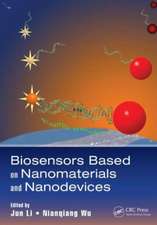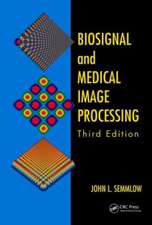Handbook of Harnessing Biomaterials in Nanomedicine: Preparation, Toxicity, and Applications
Editat de Dan Peeren Limba Engleză Hardback – 12 ian 2012
| Toate formatele și edițiile | Preț | Express |
|---|---|---|
| Hardback (2) | 900.06 lei 6-8 săpt. | |
| Jenny Stanford Publishing – 12 ian 2012 | 900.06 lei 6-8 săpt. | |
| Jenny Stanford Publishing – 26 ian 2021 | 1025.88 lei 6-8 săpt. |
Preț: 900.06 lei
Preț vechi: 1097.63 lei
-18% Nou
Puncte Express: 1350
Preț estimativ în valută:
172.25€ • 179.17$ • 142.20£
172.25€ • 179.17$ • 142.20£
Carte tipărită la comandă
Livrare economică 15-29 aprilie
Preluare comenzi: 021 569.72.76
Specificații
ISBN-13: 9789814316460
ISBN-10: 9814316466
Pagini: 424
Ilustrații: 8 page 4-color insert goes at end of book; 15 Illustrations, color; 30 Illustrations, black and white
Dimensiuni: 152 x 229 x 23 mm
Greutate: 0.7 kg
Ediția:UK edition
Editura: Jenny Stanford Publishing
Colecția Jenny Stanford Publishing
ISBN-10: 9814316466
Pagini: 424
Ilustrații: 8 page 4-color insert goes at end of book; 15 Illustrations, color; 30 Illustrations, black and white
Dimensiuni: 152 x 229 x 23 mm
Greutate: 0.7 kg
Ediția:UK edition
Editura: Jenny Stanford Publishing
Colecția Jenny Stanford Publishing
Public țintă
Academic and PostgraduateCuprins
Biomaterial-Based Particulate Drug Carriers. Single-Chain Polymer Nanoparticles for Application in Nanomedicine. Polyethylene Glycol Polyester Block Co-Polymers: Biocompatible Carriers for Nanoparticulate Drug Delivery. Recent Progress in Polymer Therapeutics as Nanomedicines. Polysaccharides as Nanomaterials for Therapeutics. RNAi as New Class of Nanomedicines. Novel RNA Interference (RNAi)-Based Nanomedicines for Treating Viral Infections. Detection and Description of Tissue Disease: Advances in the Use of Nanomedicine for Medical Imaging. Image-Based High-Content Analysis, Stem Cells and Nanomedicines: A Novel Strategy for Drug Discovery. Wrong Resemblance? Role of the Immune System in the Biocompatibility of Nanostructured Materials. Complement Activation, Immunogenicity and Immune Suppression as Potential Side Effects of Liposomes. The Story of DOXIL — A Personal Account.
Notă biografică
Dan Peer is a principal investigator and a senior lecturer and leads an NIH-funded laboratory at Tel Aviv University, Israel. Dan completed his education in biochemistry and biophysics from Tel Aviv University, Israel. From January 2005 to August 2008, he worked at Harvard Medical School. He joined the Department of Cell Research and Immunology, in the Faculty of life sciences at Tel Aviv University in September 2008 to establish the laboratory of nanomedicine. Dan’s research was between the first to demonstrate systemic delivery of RNAi using targeted nano-carriers to the immune system and the first to utilize RNAi for in vivo validation of new drug targets within the immune system. His work was published in premier scientific journals such as Science, Nature Nanotechnology, and PNAS. He is the editor and author of several books in the field of nanomedicine, an associate editor of Journal of Biomedical Nanotechnology, and Frontiers in Biotechnology and Drug Delivery, and on the editorial board of the journals Nanotechnology and Journal of Controlled Release. Dan has received more than 20 awards and honors.
Recenzii
"The nanomedicine revolution has begun. To date, nearly 30 nanotechnology-based products have been approved for clinical use, including liposomal formulations and stealth polymer–drug conjugates. Importantly, the application of nanotechnology to medicine will continue to progressively and fundamentally change the landscape for the pharmaceutical and biotechnology industries. Dan Peer has done an exceptional job bringing together the world’s leading experts to provide an authoritative compilation covering the essential fundamentals and state-of-the-art approaches. The book includes essential methods for preparing nanomaterials, testing the function, and analyzing their safety with relevance to potential regulatory hurdles that may be encountered. This book will undoubtedly become an essential reference for scientists and technologists who aim to characterize, study, and develop clinically relevant and safe nanomedicines."
—Prof. Jeffrey M. Karp - Harvard Stem Cell Institute, USA
"This book is a compendium of recent developments in nanomedicine and advanced drug delivery systems that highlight leading laboratories’ key findings on nanomaterial design, selection, and adverse effects. It is a valuable reference for both students and researchers."
—Prof. S. Moein Moghimi - University of Copenhagen, Denmark
—Prof. Jeffrey M. Karp - Harvard Stem Cell Institute, USA
"This book is a compendium of recent developments in nanomedicine and advanced drug delivery systems that highlight leading laboratories’ key findings on nanomaterial design, selection, and adverse effects. It is a valuable reference for both students and researchers."
—Prof. S. Moein Moghimi - University of Copenhagen, Denmark
Descriere
This book concentrates on the use of biomaterials in nanomedicine. The areas of focus include drug delivery by polymers, lipids, and carbohydrates for the delivery of small molecules, RNA interference, and proteins; the use of nano-proteins such as antibodies and peptides as targeting agents for therapeutics and diagnosis; the use of nanocarrier-based biomaterials for manipulation of stem cells; different aspects of toxicity of nanocarriers (the immune response, liver toxicity, and many more); and success stories of biomaterials that have reached the clinics. The book covers theoretical and experimental analysis of various biomaterials that are used in nanomedicine, research methods and preparation techniques, and several promising applications.



















